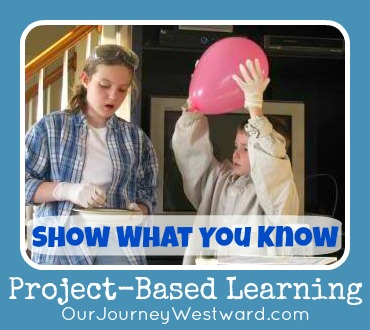Project-Based Learning: Show What You Know
Show what you know projects have been super motivating for my children. Why? With these projects, my kiddos pretty much get a few simple guidelines then have free reign to put together whatever type of project and/or presentation they want…as long as they SHOW WHAT THEY KNOW and show it thoroughly and knowledgeably.

How Show What You Know Works
Just like everything else with homeschooling, show-what-you-know can work in whatever way floats your family’s boat. I’ll share a few examples and let your imagination take over from there.
Project-based learning is partly about freedom for your child. Freedom to make some decisions about what to study; freedom to make some project decisions; and freedom to work in ways that motivate them to dive deep into a subject. In all our PBL, I try to keep my children involved with at least some of the decision making. In show-what-you-know projects, my children have the most leeway from start to finish.
Some Practical Examples:
End of Year “Test”
After studying chemistry in upper elementary and middle school, I told my two big kids that their “final exam” would be a presentation. The only parameters were to make it clear they understood the main concept from each and every chapter we had studied throughout the year.
They chose to put together a science show. Each chapter’s content was demonstrated through an experiment with thorough explanations of how/why the experiments worked. On their own, they put together informational posters, wore “scientist gear”, and shared the responsibility of presenting experiments and explanations.
With the research and review involved in this project, there was truly no need at all for a “real” test.
History Culminating Project
Culminating simply means “ending.” My son is currently at the end of a Revolutionary War study. He’s working on a technology presentation as his show-what-you-know project. Through a Power Point presentation, he has to show that he really understood the importance of the war, as well as important events and important people. Once it’s finished, he will be posting it on his YouTube channel. This a great project for him to show comprehension, practice a unique style of writing, and learn a new technology skill.
Prove It
Once upon a time, my children were convinced they already knew enough about a subject and pleaded with me to skip learning about it. How can a homeschool mom possibly consider skipping something? Easy! I told them, “Okay, you have one week to prove to me that you “get” it. At the end of the week, you better have a knock-out show-what-you-know project. If so, we skip it. If not, you’ll get double duty work to catch up.
Um, they got it. Since this was a science topic, they again chose to prove their knowledge through a series of experiments and explanations. Time saved.
Where to Add Show-What-You-Know Projects
- At the end of a unit study
- At the end of a chapter in a textbook
- As a final exam
- In place of normal work (like textbook reading and/or worksheets) – especially if your child claims he already knows it
- Before a unit study – so you can pinpoint what your children already know and what truly needs to be covered
I’m not going to take time in this series to talk about how I hold my children accountable during project based learning, but I will mention that we ALWAYS work together to set up a guide of what an acceptable project will contain. We sometimes make rubrics together, but usually just list the criteria for what mom will accept. If the project doesn’t meet that expectation, the kids have work to do to get the project up to par.
Join me tomorrow for project-based nature study ideas!
Learn More About Project-Based Learning
Project-based learning is such a powerful tool for your homeschool! This Homeschool Masterclass will help you learn why and give you all kinds of practical tips to implement it successfully.

